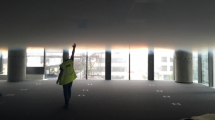Abstract
Based on studies conducted by the Division of Building Research, the authors analyzed the most important factors that determine expectation of life loss from smoke in high-rise buildings.
Similar content being viewed by others
References
McGuire, J. H., “Smoke Movement in Buildings,”Fire Technology, Vol. 3, No. 3, (Aug. 1967), pp. 163–174.
Galbreath, M., “Time of Evacuation by Stairs in High Buildings,” Fire Research Note 8, National Research Council of Canada, Division of Building Research, 1969.
Wilson, A. G., and G. W. Shorter, “Fire and High Buildings,”Fire Technology, Vol. 6, No. 4 (Nov. 1970), pp. 292–304.
Lie, T. T., “Optimum Fire Resistance of Structures,”Journal of the Structural Division, ASCE, Vol. 98, No. STI (1972), pp. 215–232.
Shorter, G. W., “Fire in Tall Buildings,” Fire Research Note No. 7, National Research Council of Canada, Division of Building Research, 1968.
Galbreath, M., “Fire in High Buildings,” Fire Study No. 21, National Research Council of Canada, Division of Building Research, 1968.
Tamura, G. T., J. H. McGuire and A. G. Wilson, “Air-Handling Systems for Control of Smoke Movement,” ASHRAE Symposium Bulletin “Fire Hazards in Buildings”, 1970, pp. 14–19.
Wilson, A. G., and G. T. Tamura, “Stack Effect in Buildings,” Canadian Building Digest 104, National Research Council of Canada, Division of Building Research, 1968.
McGuire, J. H., “Control of Smoke in Buildings,”Fire Technology, Vol. 3, No. 4 (Nov. 1967), pp. 281–290.
Hutcheon, N. B., “Fire Protection in Air System Installations,”Heating, Piping and Air Conditioning, Vol. 40, No. 12 (1968), pp. 102–106.
Tamura, G. T., and A. G. Wilson, “Pressure Differences Caused by Wind on Two Tall Buildings,”ASHRAE Transactions, Vol. 74, Part II (1968), pp. 170–181.
Hutcheon, N. B., and G. W. Shorter, “Smoke Problems in High-Rise Buildings,”ASHRAE Journal, Vol. 10, No. 9 (1968), pp. 57–61.
Tamura, G. T., “Computer Analysis of Smoke Movements in Tall Buildings,”ASHRAE Transactions, Vol. 75, Part II (1969), pp. 81–92.
Tamura, G. T., and A. G. Wilson, “Pressure Differences Caused by Chimney Effect in Three High Buildings,”ASHRAE Transactions, Vol. 73, Part II (1967).
McGuire, J. H., G. T. Tamura and A. G. Wilson, “Factors in Controlling Smoke in High Buildings,” ASHRAE Symposium Bulletin “Fire Hazards in Buildings,” 1970, pp. 8–13.
Lie, T. T., “Smoke Contribution of Some Partition Components During a Fire Test,” Technical Note No. 524, National Research Council of Canada, Division of Building Research, 1968.
Author information
Authors and Affiliations
Rights and permissions
About this article
Cite this article
Lie, T.T., McGuire, J.H. Control of smoke in high-rise buildings. Fire Technol 11, 5–14 (1975). https://doi.org/10.1007/BF02589996
Issue Date:
DOI: https://doi.org/10.1007/BF02589996




